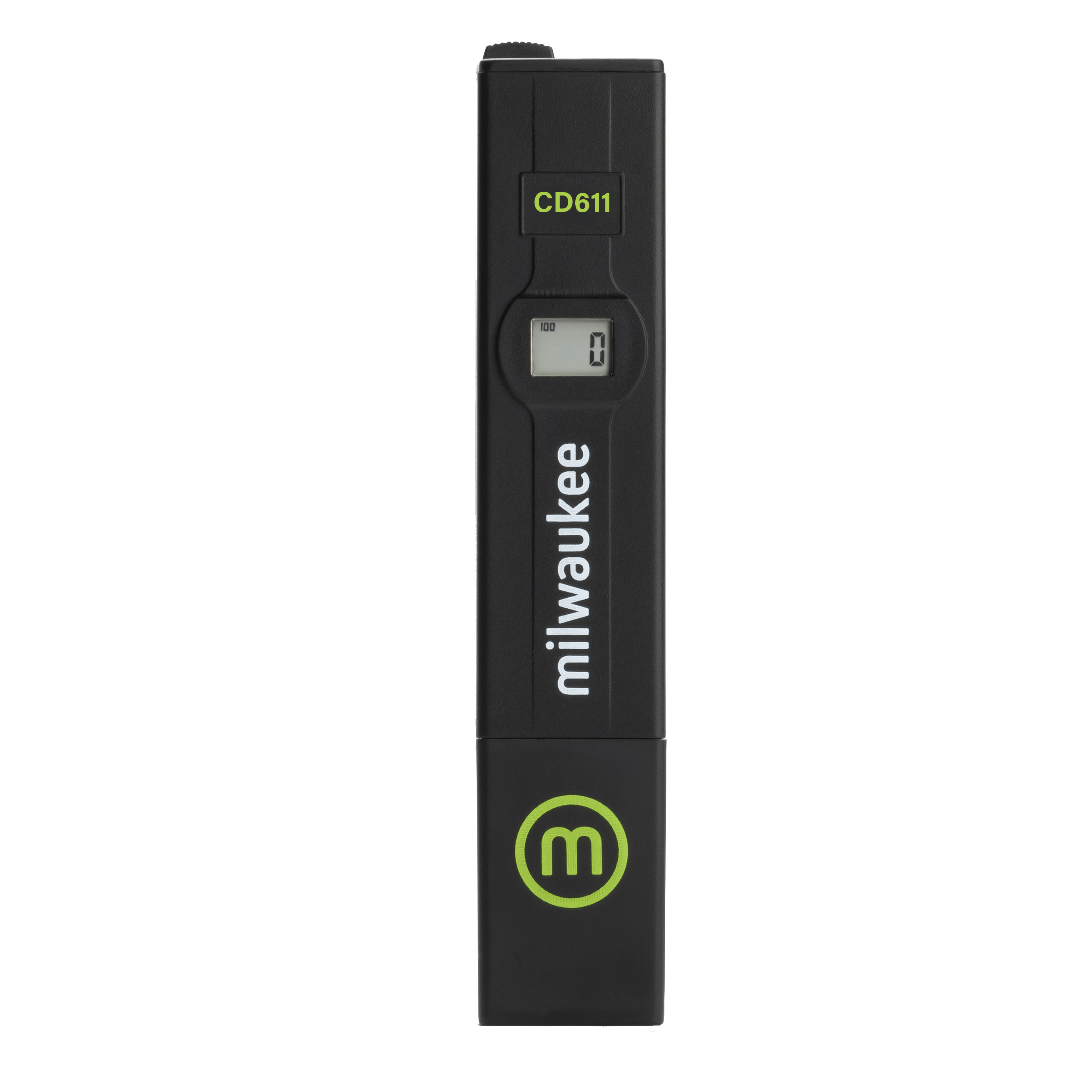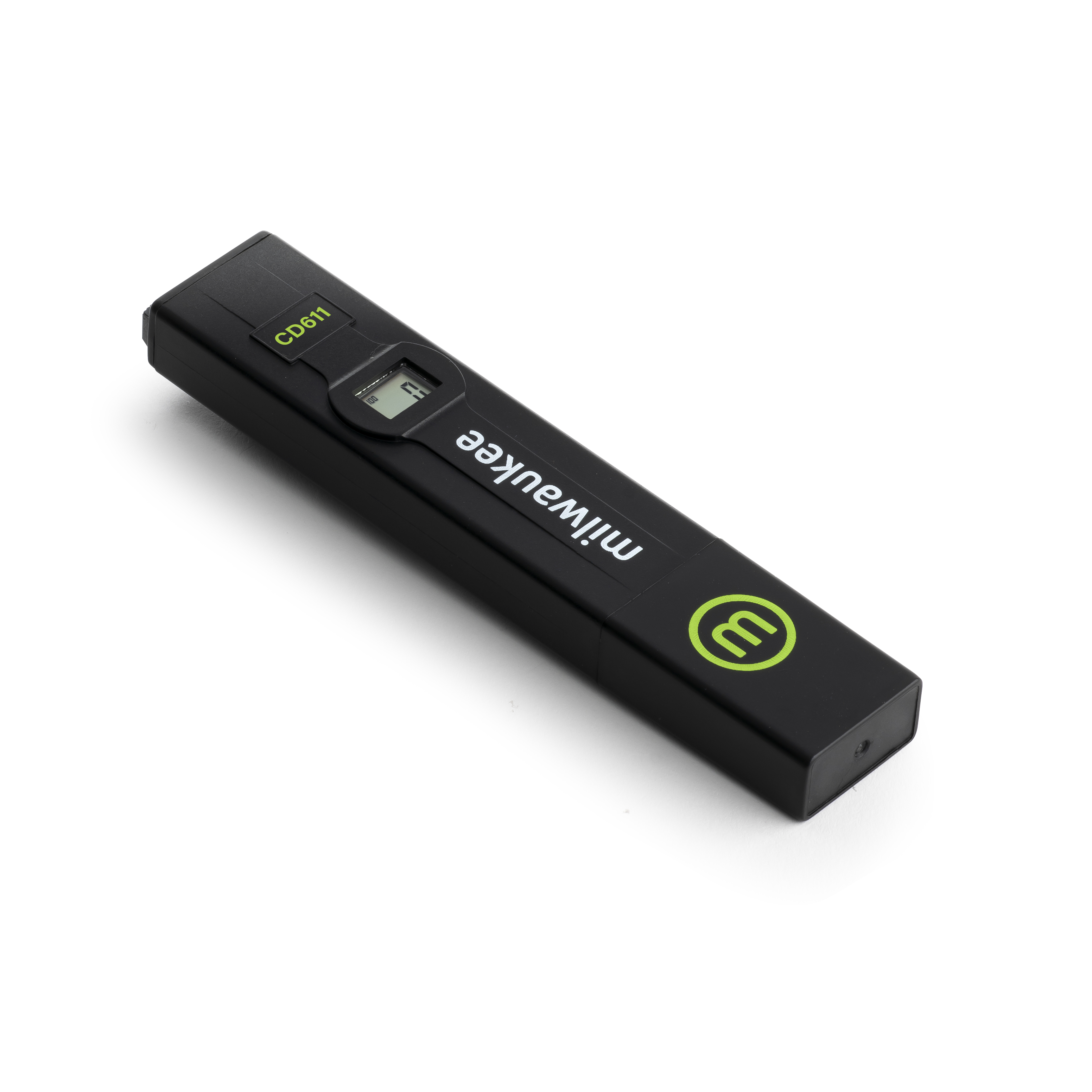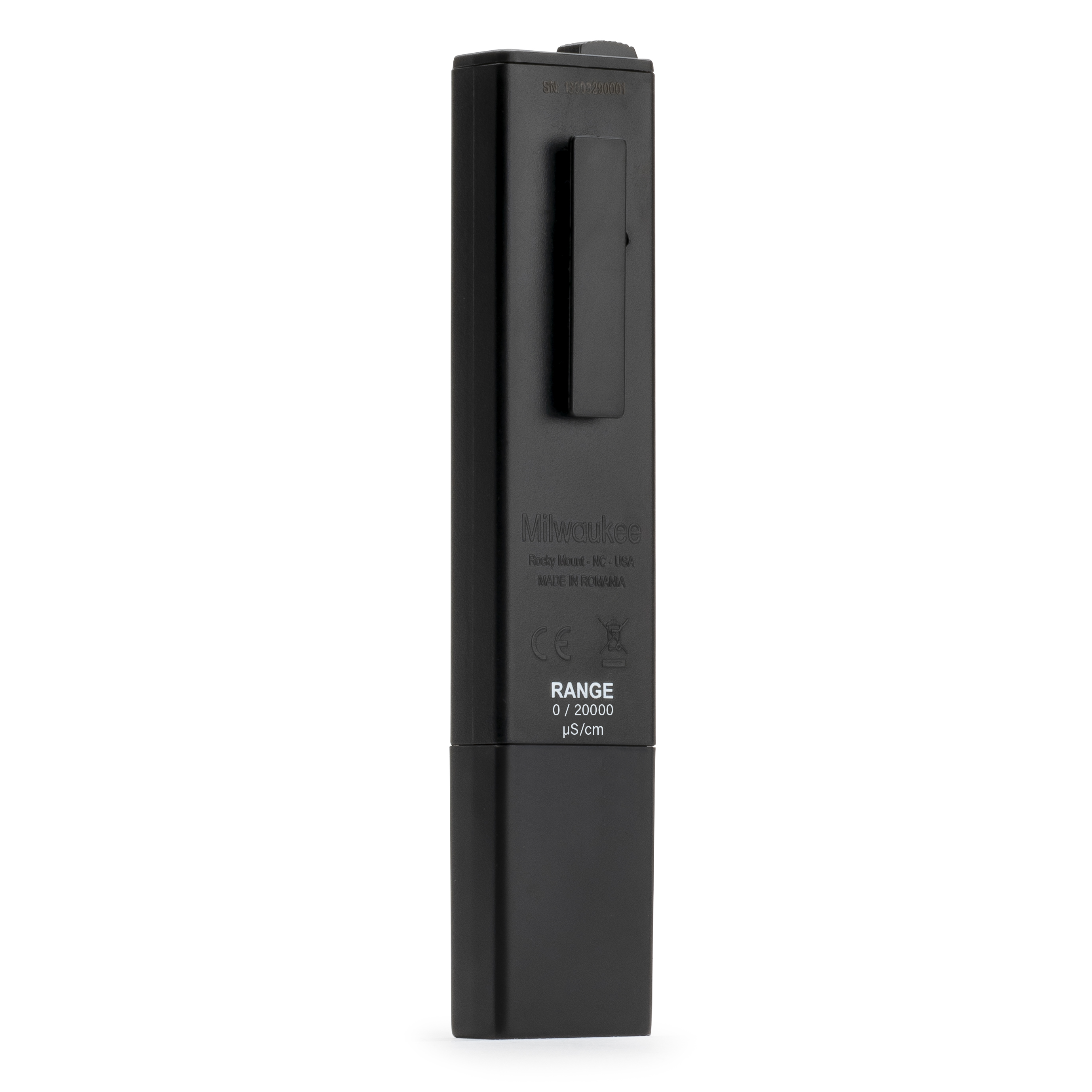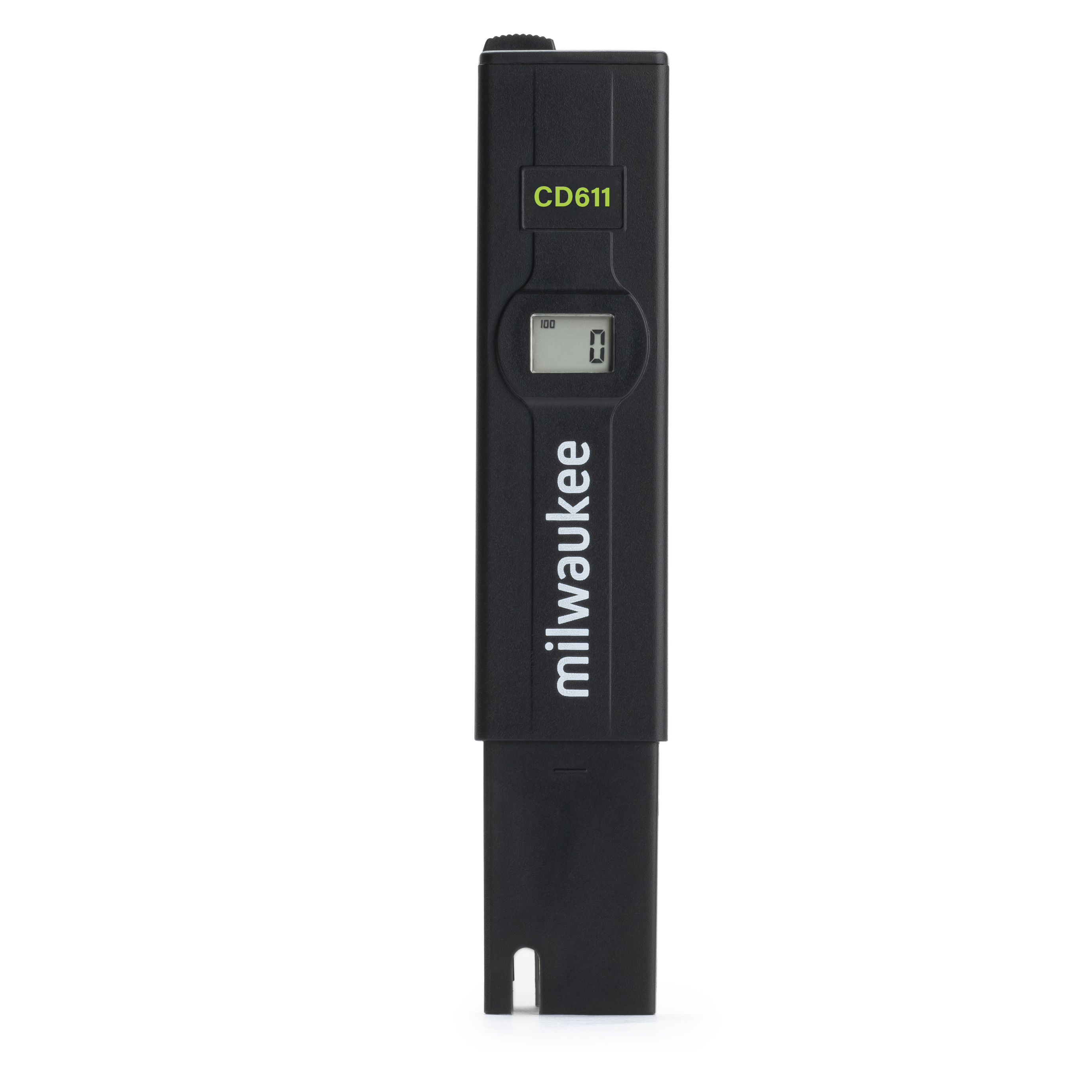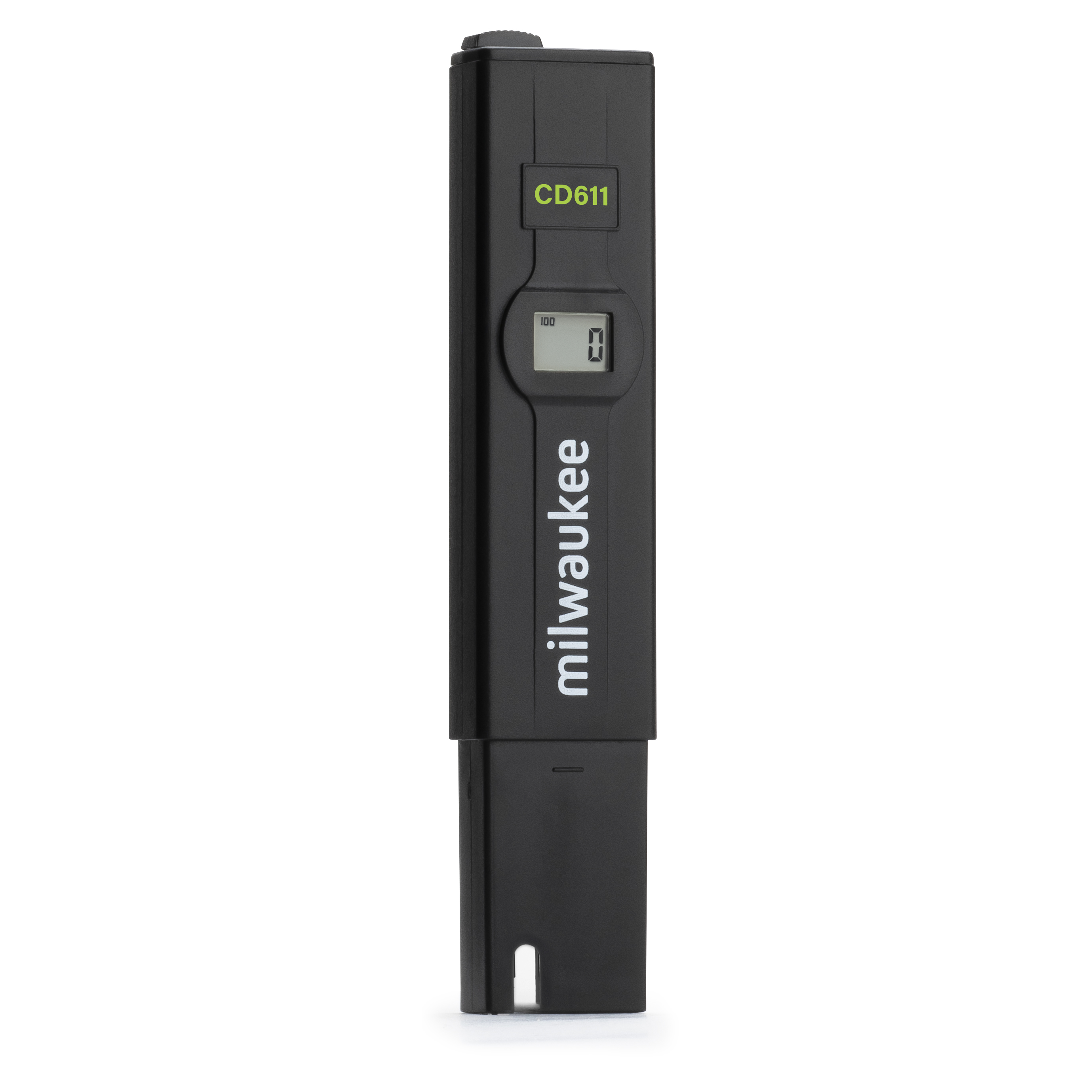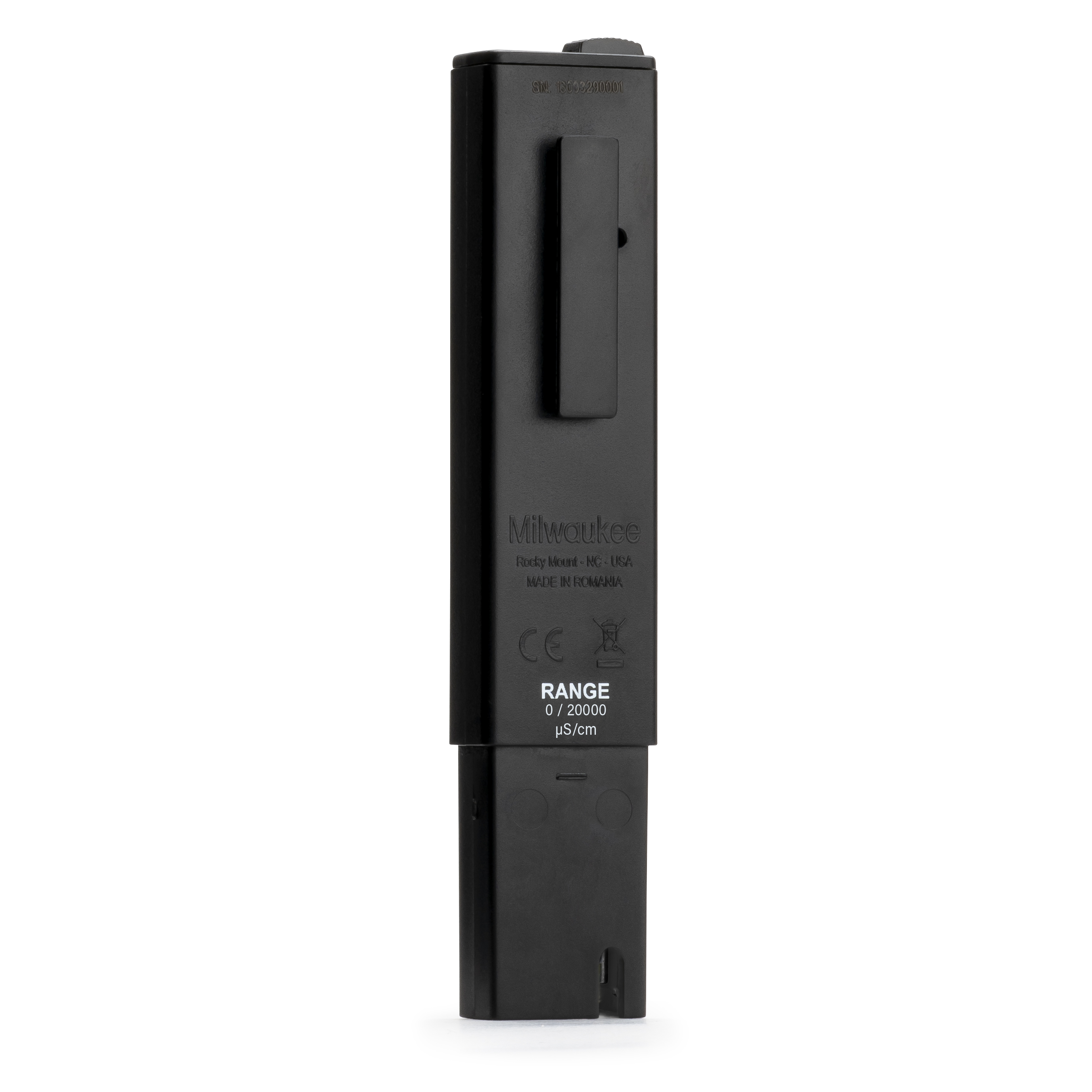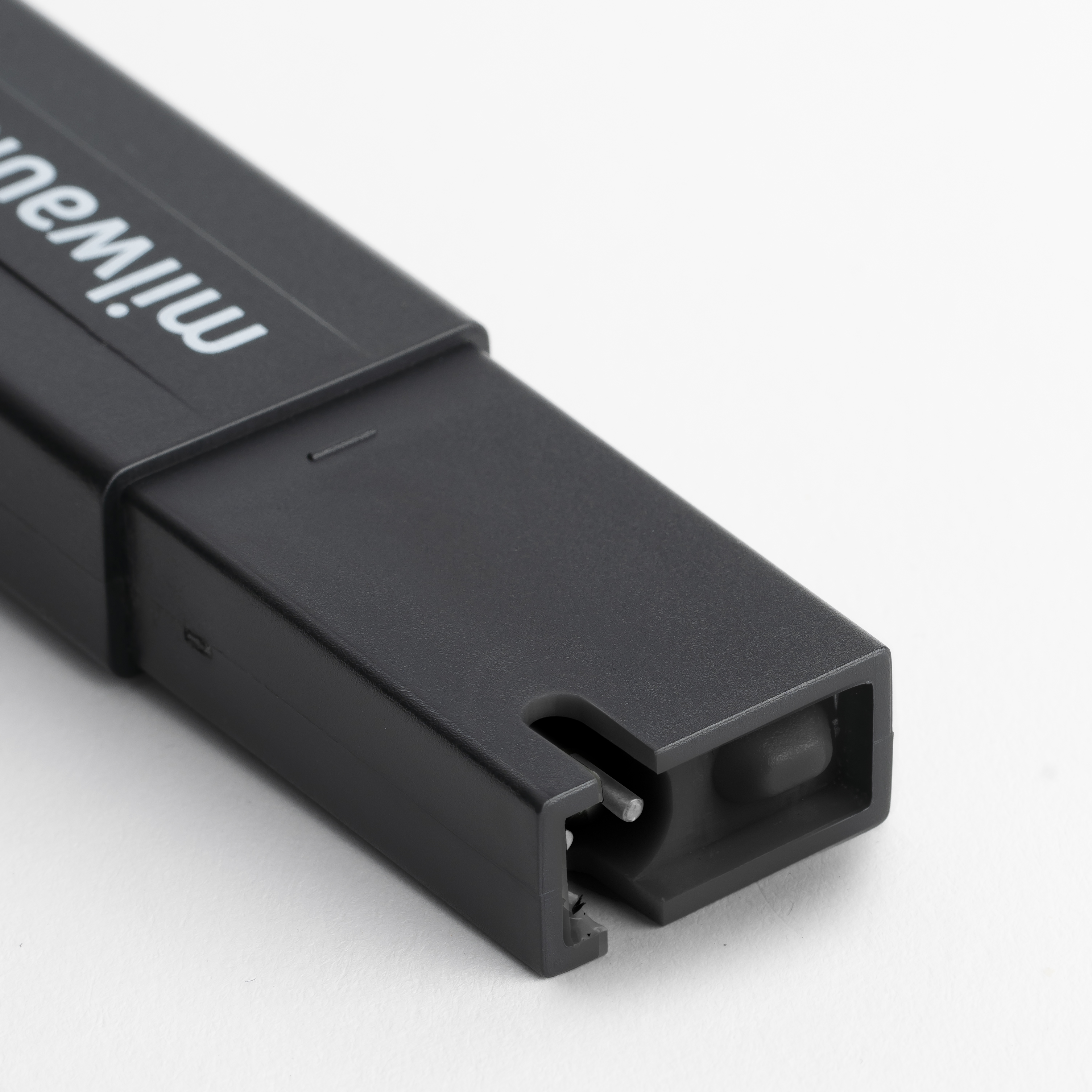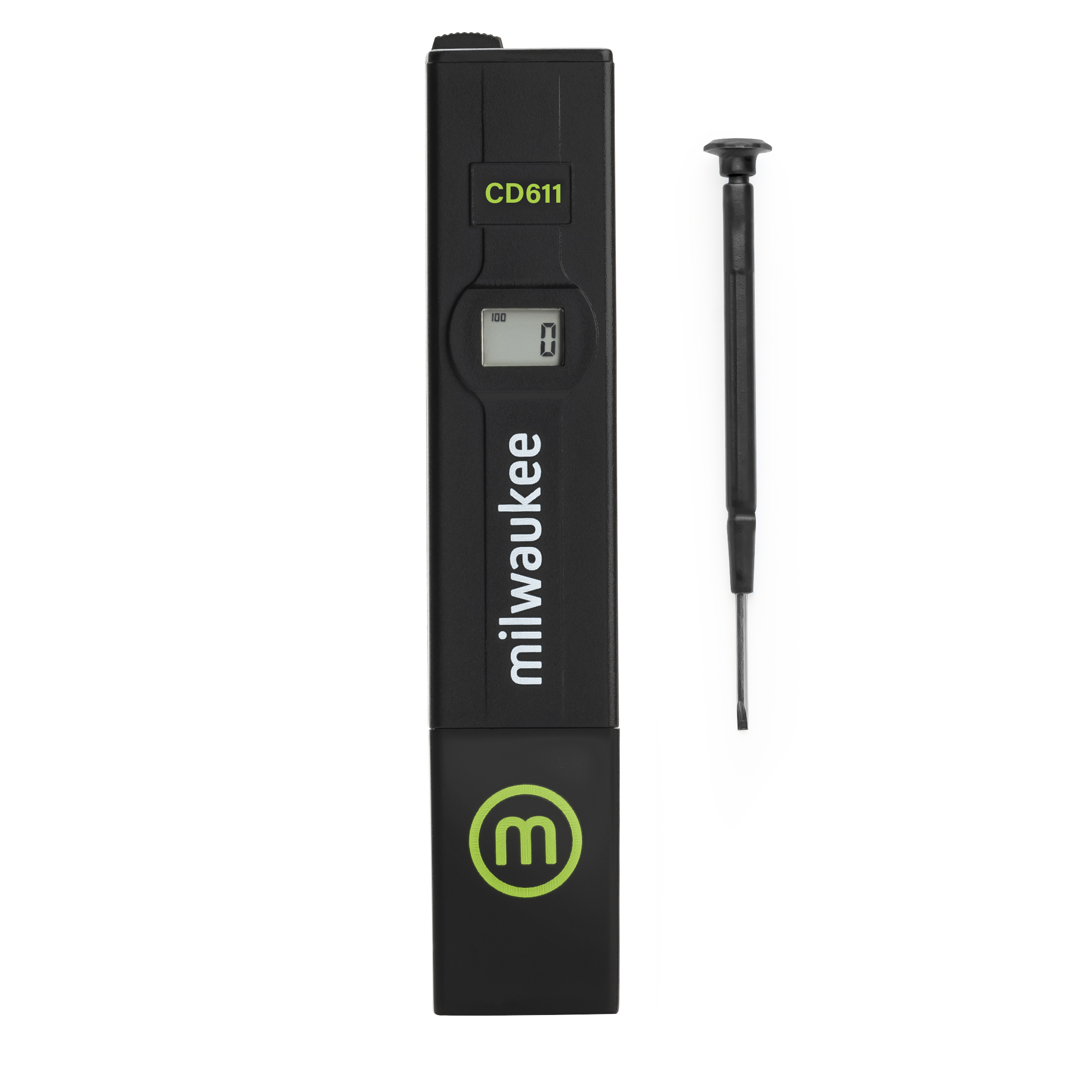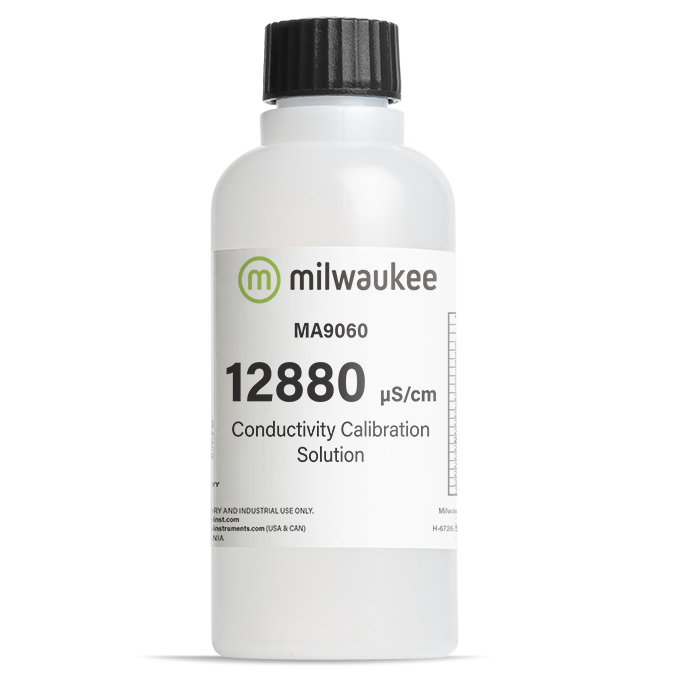Your shopping cart is currently empty.
€34.31
Milwaukee CD611 Digital Conductivity Pen (EC)
Milwaukee CD611 Conductivity Tester – Reliable, Simple,
and Accurate EC Measurement
The Milwaukee CD611 Conductivity Tester is designed for
users who need fast, accurate, and reliable electrical conductivity (EC)
measurements across a wide range of applications. Whether you’re a hydroponic
grower fine-tuning nutrient solutions, an aquarist monitoring water quality, or
an educator teaching essential chemistry concepts, the CD611 offers an
easy-to-use solution with professional-level performance.
With a compact, lightweight design and easy one-point manual calibration, the
CD611 is ideal for quick field tests and everyday use. Its precision ±2% Full
Scale EC accuracy makes it a trusted tool for professionals and hobbyists
alike.
Built to deliver dependable results at an affordable price, the CD611 ensures
you can monitor conductivity levels confidently—helping you protect your
plants, aquatic life, equipment, and processes with ease.
Why Choose the Milwaukee CD611?
- Fast, Accurate Results – ±2% Full Scale EC accuracy for dependable readings.
- Simple One-Point Calibration – Quick and easy manual calibration ensures ongoing precision.
- Compact & Lightweight – Convenient to carry for on-the-go testing.
- Long Battery Life – Up to 250 hours of continuous use with a single battery.
- Easy-to-Read LCD Display – Clear digital display for fast data interpretation.
Applications
Agriculture & Hydroponics
- Monitoring nutrient solution concentration for optimal plant growth.
- Checking salinity levels in soil and hydroponic systems.
Aquariums & Fish Farming
- Measuring water conductivity to maintain a stable, healthy aquatic environment.
- Monitoring salinity in freshwater and saltwater systems.
Swimming Pools & Spas
- Ensuring correct salt levels in saltwater pools and spas for safe and efficient operation.
Food & Beverage Production
- Testing water quality used in food and beverage manufacturing processes.
- Monitoring cleaning solutions (CIP systems) conductivity.
Laboratory & Education
- Performing basic water quality testing in school experiments and laboratory settings.
- Teaching conductivity principles in educational programs.
Industrial Applications
- Checking conductivity in cooling towers and boilers to prevent scaling and corrosion.
- Monitoring wastewater treatment processes.
Drinking Water & Water Treatment
- Verifying the quality of potable water by measuring its conductivity.
- Monitoring performance of water filtration and desalination systems.
Environmental Monitoring
- Testing natural water bodies (rivers, lakes) for pollution levels via conductivity measurement.
- Field sampling for environmental research and protection programs.
Proper Care & Maintenance
To ensure accurate and long-lasting performance, proper maintenance of your Milwaukee CD611 Conductivity Tester is essential.
- Always rinse the probe with distilled or deionized water after each use to avoid contamination buildup.
- Store dry between uses to preserve probe sensitivity and prevent damage.
- Calibrate regularly using a conductivity standard solution to maintain measurement accuracy.
- Avoid immersing the tester beyond the maximum immersion level indicated on the device.
- Replace
batteries when the low battery indicator appears to ensure reliable
operation.
CONVERTING EC TO TDS
The Milwaukee EC Pen, like all conductivity meters, provides a measure of electrically charged ions in a solution and is an absolute measure of conductivity.
EC is often converted to TDS in parts per million (ppm). Different scales include the 500 scale, 650 scale and the 700 scale. However, true PPM can only be determined through chemical analysis.
Your mS/cm reading can be approximately converted to TDS (ppm) as shown in the examples below.
2,000 µS/cm = 2.0 mS/cm = 1000 ppm on .50 factor scale
2,000 µS/cm = 2.0 mS/cm = 1400 ppm on the 442 scale or .70 factor scale
Following these simple steps will help you extend the life of your CD611 and maintain the precision you need for your daily conductivity measurements.
Order the Milwaukee CD611 Today!
Whether you’re growing plants, raising fish, maintaining a pool, or conducting water quality tests, the Milwaukee CD611 Conductivity Tester delivers reliable performance you can trust. Invest in accurate, affordable EC measurement—order your CD611 today!
Specifications
Application
Agriculture & Hydroponics
Maintaining optimal nutrient levels is vital for healthy plant growth in both soil-based agriculture and hydroponic systems. Conductivity (EC) testing plays a crucial role by providing a direct measurement of the concentration of dissolved salts (nutrients) in the water or soil solution.
In hydroponics, the nutrient solution is the lifeblood of your plants. Too low EC can lead to nutrient deficiencies, while too high EC can cause nutrient burn and stunted growth. Regular monitoring ensures that plants receive the ideal balance of minerals for vigorous development and maximum yield.
In traditional agriculture, checking soil salinity is equally important. Elevated salt levels can inhibit water uptake, reduce crop productivity, and lead to long-term soil degradation. Early detection through conductivity testing allows for timely adjustments to irrigation practices and fertilization strategies, protecting soil health and improving crop outcomes.
The Milwaukee CD611 Conductivity Pen makes it easy for growers to monitor EC levels quickly and accurately, helping to create the perfect growing environment—whether in soil, hydroponic systems, greenhouses, or controlled environments.
How to Use for Agriculture & Hydroponics:
- Calibrate the CD611 with a conductivity calibration solution to ensure accuracy.
- Rinse the probe with clean water to avoid contamination.
- Submerge the probe into the nutrient solution or soil runoff sample.
- Stir gently if needed and wait for the reading to stabilize.
- Compare the reading against the target EC range for your specific crop or growth stage.
- Adjust nutrient concentrations as necessary to maintain optimal levels.
By integrating regular conductivity testing into your cultivation practices, you can promote stronger, healthier plants, achieve better harvests, and maintain the long-term fertility of your growing medium.
Aquariums & Fish Farming
Water quality is the foundation of a healthy and thriving aquatic environment. In both freshwater and saltwater systems, maintaining stable salinity and mineral balance is critical for the well-being of fish, plants, and beneficial bacteria. Conductivity testing provides a fast and accurate method to monitor the total concentration of dissolved salts in the water, which directly impacts the overall health of the ecosystem.
In freshwater aquariums, conductivity monitoring helps detect shifts caused by water changes, evaporation, or the accumulation of waste products. Consistent readings indicate a stable environment, while sudden changes can signal issues such as overfeeding, poor filtration, or contamination.
In saltwater aquariums and fish farming operations, controlling salinity is essential. Marine species are highly sensitive to variations, and even minor fluctuations can cause stress, illness, or death. Regular conductivity testing ensures that salinity levels remain within the optimal range, supporting the health, growth, and reproduction of aquatic life.
The Milwaukee CD611 Conductivity Pen provides aquarists and fish farmers with an easy-to-use, reliable tool for monitoring water conditions, helping to prevent problems before they arise and maintain vibrant, stable aquatic ecosystems.
How to Use for Aquariums & Fish Farming:
- Calibrate the CD611 with a conductivity calibration solution appropriate for your water type (freshwater or saltwater).
- Rinse the probe with distilled or deionized water to prevent cross-contamination.
- Immerse the probe directly into the aquarium or tank water.
- Allow the reading to stabilize while holding the pen steady.
- Compare the conductivity value to recommended levels for your specific species and system.
- Adjust water salinity if necessary by adding freshwater or marine salts.
By integrating regular conductivity checks into your aquarium maintenance or fish farming routine, you can create a safer, healthier environment for aquatic life and promote long-term success.
Swimming Pools & Spas
Proper salt concentration is crucial for the safe and efficient operation of saltwater pools and spas. Saltwater systems rely on a precise level of dissolved salts to generate chlorine through electrolysis, providing effective sanitation while offering a gentler swimming experience compared to traditional chlorinated pools. Monitoring conductivity, which correlates directly to salt concentration, ensures that the system operates at peak performance, keeping the water clean, comfortable, and safe.
If salt levels are too low, the chlorine generator may not produce enough sanitizer, leading to cloudy water and the risk of harmful bacterial growth. If salt levels are too high, it can damage pool equipment, corrode surfaces, and create an uncomfortable swimming environment. Regular conductivity testing helps maintain the ideal salt range, protecting both the health of swimmers and the longevity of your pool or spa system.
The Milwaukee CD611 Conductivity Pen offers a simple and accurate way to measure salt concentrations, helping pool owners and spa operators manage water quality with confidence and ease.
How to Use for Swimming Pools & Spas:
- Calibrate the CD611 with a conductivity standard solution suitable for saltwater measurements.
- Rinse the probe with clean, distilled water before testing to avoid contamination.
- Immerse the probe into the pool or spa water at a depth of at least a few inches.
- Wait for the reading to stabilize, then note the conductivity value.
- Compare the measurement to the recommended conductivity/salt concentration for your specific pool or spa system (typically around 2500–4000 ppm depending on manufacturer guidelines).
- Adjust salt levels if necessary by adding salt or diluting with fresh water.
Routine monitoring with the CD611 ensures balanced salt levels, resulting in a better swimming experience, reduced chemical costs, and prolonged equipment life.
Food & Beverage Production
In the food and beverage industry, water quality is critical to ensuring product safety, consistency, and flavor. Conductivity testing provides a simple and effective way to monitor the purity of water used in production processes, from ingredient mixing to rinsing and final product preparation. High conductivity readings can indicate the presence of dissolved salts or contaminants, which could affect taste, shelf life, and regulatory compliance.
Additionally, conductivity measurement plays a vital role in monitoring Clean-in-Place (CIP) systems, where cleaning and sanitizing solutions must be accurately maintained to ensure thorough equipment cleaning without leaving residues. By regularly measuring the conductivity of these solutions, manufacturers can verify correct concentrations, optimize cleaning efficiency, and avoid cross-contamination.
The Milwaukee CD611 Conductivity Pen offers fast and reliable readings, making it an essential tool for food and beverage professionals committed to quality and safety at every stage of production.
How to Use for Food & Beverage Production:
- Calibrate the CD611 with an appropriate standard solution for your target conductivity range.
- Rinse the probe with distilled water before each test to ensure accuracy.
- Submerge the probe in the water source or CIP solution.
- Allow the reading to stabilize, then record the conductivity measurement.
- Interpret the results according to your process requirements:
- For water quality, ensure conductivity stays within industry standards for purity.
- For CIP systems, verify that cleaning solution concentrations meet manufacturer or regulatory guidelines.
- Adjust water treatment processes or cleaning solution concentrations as needed based on the results.
By incorporating regular conductivity testing into production and cleaning routines, food and beverage manufacturers can safeguard product integrity, improve operational efficiency, and maintain the highest hygiene standards.
Laboratory & Education
In both educational and laboratory environments, conductivity measurement serves as a fundamental tool for understanding water chemistry and solution properties. Whether used in basic science classes, university research, or routine laboratory testing, conductivity testing helps students and researchers assess the level of dissolved ions in water and other liquids.
For schools and educational programs, the Milwaukee CD611 Conductivity Pen provides an accessible and practical way to demonstrate conductivity principles, ion concentration, and the relationship between electrical conductivity and water quality. In laboratories, it enables quick and reliable testing during experiments, research projects, and quality control processes.
Thanks to its compact design and easy operation, the CD611 is an excellent instrument for introducing learners to electrochemical measurements while also meeting the demands of professional laboratory work.
How to Use for Laboratory & Educational Applications:
- Calibrate the CD611 with a standard conductivity calibration solution to ensure accuracy.
- Rinse the probe with distilled water between different samples to prevent contamination.
- Immerse the probe in the sample solution or water to be tested.
- Wait for the reading to stabilize, then record the conductivity value displayed.
- Analyze the results:
- In education, use the measurements to illustrate how dissolved salts and impurities affect conductivity.
- In laboratories, use the data for experiments requiring precise water quality analysis.
By incorporating the Milwaukee CD611 into educational and laboratory activities, users gain hands-on experience with essential scientific concepts while ensuring consistent and dependable measurements.
Industrial Applications
In industrial environments, accurate conductivity measurement is vital for maintaining the efficiency, safety, and longevity of critical systems. In facilities that operate cooling towers, boilers, or wastewater treatment plants, monitoring water conductivity helps prevent costly problems such as scaling, corrosion, and inefficient system performance.
High conductivity in cooling and boiler systems can indicate excess dissolved salts, leading to mineral buildup (scaling) that reduces heat transfer efficiency and damages equipment. Conversely, low conductivity could signal the need for chemical adjustments to prevent corrosion. In wastewater treatment, conductivity monitoring provides key insights into the concentration of dissolved solids, helping operators ensure that discharge water meets environmental regulations and process requirements.
The Milwaukee CD611 Conductivity Pen offers a compact, user-friendly solution for on-the-spot testing, making it an essential tool for maintenance teams, plant operators, and quality control personnel.
How to Use for Industrial Applications:
- Calibrate the CD611 with an appropriate standard conductivity solution for industrial ranges.
- Rinse the probe with distilled or deionized water to avoid cross-contamination between samples.
- Submerge the probe into the water sample from the cooling system, boiler feedwater, or wastewater outlet.
- Allow the reading to stabilize, then note the conductivity measurement.
- Analyze the results:
- Compare readings to operational targets for cooling towers or boilers and adjust chemical dosing accordingly.
- In wastewater processes, use conductivity trends to monitor treatment effectiveness and detect anomalies in inflow or outflow water quality.
Using the Milwaukee CD611 ensures proactive maintenance, regulatory compliance, and optimized performance across a wide range of industrial water management applications.
Drinking Water & Water Treatment
Ensuring the quality and safety of drinking water is a top priority for municipalities, treatment facilities, and private water systems. Conductivity measurement serves as a quick and effective indicator of water purity by reflecting the concentration of dissolved ions. Higher conductivity often signals the presence of contaminants such as salts, metals, or chemicals that may affect taste, safety, or compliance with regulatory standards.
In water treatment processes—including filtration and desalination systems—conductivity testing is critical for monitoring system performance. A sudden rise in conductivity can indicate membrane failure, filter exhaustion, or leaks, allowing operators to take corrective action before problems escalate.
The Milwaukee CD611 Conductivity Pen provides a practical, portable solution for quick spot checks, routine monitoring, and early detection of water quality issues in both potable and treated water applications.
How to Use for Drinking Water & Water Treatment:
- Calibrate the CD611 with a certified conductivity calibration solution suited for drinking water ranges.
- Rinse the probe with distilled water before and after each use to maintain accuracy.
- Immerse the probe into the drinking water sample or directly into system outflows such as post-filtration or post-desalination outlets.
- Wait for the reading to stabilize, then record the conductivity value.
- Interpret the results:
- Low conductivity typically suggests pure water, while higher readings may warrant further testing for specific contaminants.
- Use conductivity trends to monitor the health of filtration and desalination systems, scheduling maintenance when deviations are detected.
By incorporating regular conductivity testing with the Milwaukee CD611, water quality managers can maintain high standards of safety, optimize system operations, and respond swiftly to any changes in water chemistry.
Environmental Monitoring
Monitoring the health of natural water bodies is essential for protecting ecosystems and ensuring sustainable water resources. Conductivity measurement is a key tool in environmental monitoring because it provides a fast, reliable indication of the total dissolved solids (TDS) in rivers, lakes, streams, and wetlands. Changes in conductivity can signal pollution events, runoff from agriculture or industry, or natural variations that impact aquatic life.
Researchers, conservationists, and regulatory agencies use conductivity testing during field sampling to assess water quality trends over time and to respond to environmental threats. Portable instruments like the Milwaukee CD611 Conductivity Pen offer the flexibility and durability needed for testing in remote and outdoor conditions.
How to Use for Environmental Monitoring:
- Calibrate the CD611 using a standard conductivity solution that matches the expected environmental range.
- Rinse the probe with distilled water before and after each sample to prevent cross-contamination.
- Submerge the probe in the natural water body at the sampling point, ensuring it is fully covered but not touching the bottom to avoid sediment interference.
- Allow the reading to stabilize and then record the conductivity value along with sampling time and location data.
- Analyze the results:
- Sudden increases in conductivity may indicate pollution from agricultural runoff, industrial discharge, or urbanization.
- Ongoing monitoring helps detect gradual changes in water quality and supports environmental protection initiatives.
Using the Milwaukee CD611 Conductivity Pen in environmental programs enables early detection of contamination, supports compliance with environmental regulations, and aids in preserving aquatic ecosystems for future generations.



